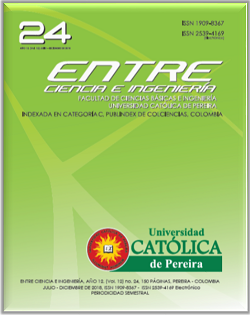Routing in wireless sensor networks using bio-inspired algorithms
DOI:
https://doi.org/10.31908/19098367.3823Keywords:
Connectivity, coverage, rror control, nodes, optimization methods, routing, swarm algorithms, simulation, wireless sensor networksAbstract
We present a solution to the problem of routing in a wireless sensor network based on Swarm Intelligence, which has been applied successfully to other routing problems, for example, the traveling salesman problem and others. Routing in a wireless sensor network can be understood as an optimization problem. In the solution presented, there are both source and destination node. The problem is focused on fi nding a path that allows optimally connecting both nodes. The search space is the complete set of possible paths that connect these two nodes. Two swarm algorithms were implemented for routing: ant—based algorithm, and bee—based algorithm. The results show that swarm intelligence improves the routing in a wireless sensor network when it is considering aspects such as the amount of energy available in the nodes. The simulations show that it produces an improvement in the lifetime of the network.
Downloads
References
I. Mohammad y M. Imad, Handbook of Sensor Networks:Compact Wireless and Wired Sensing Systems, London: CRC Press Boca Raton, 2004.
I. Akyildiz y M. Can Vuran, Wireless Sensor Nerworks, United Kingdom: Wiley, 2010.
O. H. Mondragon Martínez y Z. M. Solarte Ataíza, «Architecture for the Creation of Ubiquitous Services Devoted to Health,» Entre Ciencia e Ingeniería. , vol. 5, nº 10, pp. 9-23, 2011.
N. Aakvaag y J. Frey, «Redes de sensores inalámbricos,» Revista ABB, vol. 4, nº 2, pp. 39--42, 2006.
H. M. Ahmad Fahmy, Wireless Sensor Networks, Singapure: Springer, 2016.
D. Rocha, D. A. Lopez Sarmiento y E. Gómez Vargas, «Los sistemas Bioinspirados y su enfoque en lasolución de necesidades en la Ingeniería,» REDES DE INGENIERIA, vol. 1, nº 2, pp. 22-29, 2012.
M. Gong, L. Pan, T. Song y T. Zhang, Bio-inspired Computing – Theories and Applications, Singapore: Springer Singapore, 2016.
E. Bonabeau, M. Dorigo y G. Theraulaz, Swarm Intelligence: From Natural to Artificial Systems, New York: JASSS, 1999.
M. Lopez-Ibanez y T. Stutzle, «The Automatic Design of Multiobjective Ant Colony Optimization Algorithms,» IEEE Transactions on Evolutionary Computation, vol. 16, nº 6, pp. 861-875, 2012.
M. Dorigo y T. Stützle, Ant Colony Optimization, United States: Massachusetts Institute of Technology, 2004.
W. Alfonso, M. Muñoz, J. Lopez y E. Caicedo, «Optimización de funciones inspirada en el comportamiento de búsqueda de néctar en abejas,» de Memorias del Congreso Internacional de Inteligencia Computacional (CIIC2007), Cali, 2007.
M. Paone, L. Paladina, D. Bruneo y A. Puliafito, «A Swarm-based Routing Protocol for Wireless Sensor Networks,» de Network Computing and Applications, 2007. NCA 2007. Sixth IEEE International Symposium on, United States, 2007.
J. Chen, R. Lin, Y. Li y Y. Sun, «LQER: A Link Quality Estimation based Routing for Wireless Sensor Networks,» Sensors, vol. 8, nº 2, pp. 1025-1038., 2008.
N. Latiff, C. Tsimenidis y B. Sharif, «Energy-Aware Clustering for Wireless Sensor Networks using Particle Swarm Optimization,» de Personal, Indoor and Mobile Radio Communications, 2007. PIMRC 2007. IEEE 18th International Symposium on, United States, 2007.
C. Beltrán y C. Franco, «Wireless Sensor Networks,» Bit, vol. 2, nº 165, pp. 61-64, 2007.
R. Hidalgo y J. Moreno, «Routing Design in Wireless Sensor Networks and a Solution for Healthcare Environment,» IEEE Latin Am. Trans, vol. 9, nº 1, pp. 353-359, 2011.
I. Akyildiz, W. Su, Y. Sankarasubramaniam y E. Cayirci, «Wireless sensor networks: a survey,» Computer networks, vol. 38, nº 4, pp. 393-422, 2002.
A. Mainwaring, D. Culler, J. Polastre, R. Szewczyk y J. Anderson, «Wireless sensor networks for habitat monitoring,» de Proceedings of the 1st ACM international workshop on Wireless sensor networks and applications, New York, 2002.
A. Kaur y K. Guneet, «Enhanced ECC Algorithm for Energy Efficient Code,» 2017 4th International Conference on Signal Processing and Integrated Networks (SPIN), pp. 459-462, 2017.
J. Aguilar y A. Labrador, «Un Algoritmo de enrutamiento Distribuído para redes de comunicación basado en sistemas de hormigas,» IEEE Latin America Transactions, vol. 5, nº 8, pp. 616-625, December 2007.
J. C. Blandón y J. A. López, «Bio-Route: un simulador para redes de sensores inalámbricos,» Revista Educación en Ingeniería, vol. 7, nº 3, pp. 23-31, 2012.
J. T. Serna, REDES DE SENSORES INALÁMBRICAS, Valencia España: Biblioteca Universitat de Valencia, 2007.
Crossbow, Wireless Sensor Networks, San Jose, California: Crossbow Technology. Inc, 2007.
Downloads
Published
Issue
Section
License
Copyright (c) 2019 Entre ciencia e ingeniería

This work is licensed under a Creative Commons Attribution-NonCommercial 4.0 International License.








